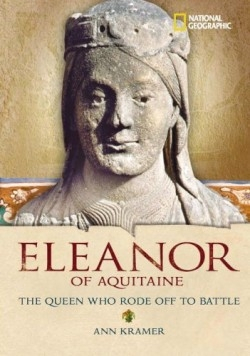Eleanor of Aquitaine
The Queen Who Rode Off to Battle
This accessible biography urges readers to celebrate the life and work of one of the most remarkable women of the Middle Ages. Born to nobility, Eleanor of Aquitaine’s (1122-1204) parents were William X, duke of Aquitaine, and Aenor, daughter of Dangerosa, the viscountess of Châtellerault. Though she was called the English name Eleanor, she was named Alia-Aenor, Latin for “the other Aenor.” During childhood, Eleanor enjoyed many of the privileges of royalty—luxurious surroundings, entertainment, travel, and the arts.
Her father’s death when she was fifteen years old ended her childhood. Suddenly, she was one of the richest women in the area, serving as duchess of Aquitaine, Poitou, and Gascony. Louis VI of France arranged Eleanor’s marriage to his son, Louis, and the couple became involved in the crusades. Instrumental during the organizing phases of the crusade, Eleanor, now the queen of France, recruited vassals and knights and coerced others, including women, to join them in their attempt to take control of Jerusalem.
Women during Medieval times had few rights, yet Eleanor managed to defy a number of limitations. Convinced her marriage to Louis VII, the king of France, was over, she divorced him though she was not allowed to have custody of their two daughters. She arranged her own second marriage, choosing the powerful duke of Normandy. Henry, duke of Normandy, and Eleanor were soon crowned king and queen of England. She governed the country in her husband’s absence, traveling, presiding over legal matters, and raising funds. While deeply involved in politics, she still managed to give birth to eight children, including Richard the Lionheart, before the marriage dissolved and she joined forces with her sons in a plot against their father. Henry imprisoned her, but Eleanor never tired of working to secure power and position for her children and grandchildren. She is revered for her ambition and business acumen.
Colorful illustrations complete with background information, sidebars, a bibliography, a welcomed glossary, and a timeline that extends the length of the book, might help those who are working on reports. Double page spreads about medieval and feudal societies, the crusades, courtly love, and the church, though they threaten to interrupt Eleanor’s story, provide a view of women’s lives during the Middle Ages. The author, a freelance writer and editor for Dorling Kindersley’s Children’s Illustrated Encyclopedia, has written two other books in National Geographic’s World History Biographies Series, Nelson Mandela: The Rebel Who Led His Nation to Freedom and Anne Frank: The Young Writer Who Told the World Her Story. Here she offers a well-researched introduction to an extraordinary woman and an interesting period in history.
Reviewed by
Kaavonia Hinton
Disclosure: This article is not an endorsement, but a review. The publisher of this book provided free copies of the book to have their book reviewed by a professional reviewer. No fee was paid by the publisher for this review. Foreword Reviews only recommends books that we love. Foreword Magazine, Inc. is disclosing this in accordance with the Federal Trade Commission’s 16 CFR, Part 255.

